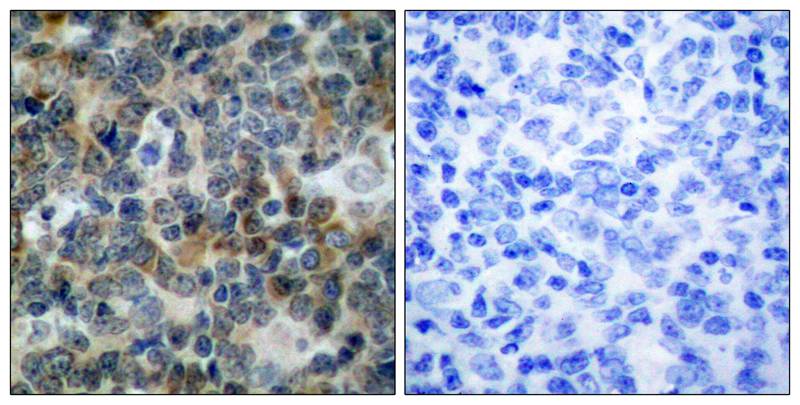

| WB | 咨询技术 | Human,Mouse,Rat |
| IF | 咨询技术 | Human,Mouse,Rat |
| IHC | 1/50-1/100 | Human,Mouse,Rat |
| ICC | 技术咨询 | Human,Mouse,Rat |
| FCM | 咨询技术 | Human,Mouse,Rat |
| Elisa | 咨询技术 | Human,Mouse,Rat |
| Entrez GeneID | 7408; |
| WB Predicted band size | 50kDa |
| Host/Isotype | Rabbit IgG |
| Antibody Type | Primary antibody |
| Storage | Store at 4°C short term. Aliquot and store at -20°C long term. Avoid freeze/thaw cycles. |
| Species Reactivity | Human,Mouse,Rat |
| Immunogen | Peptide sequence around phosphorylation site of serine 238 (K-V-S(p)-K-Q) derived from Human VASP. |
| Formulation | Purified antibody in PBS with 0.05% sodium azide. |
+ +
以下是3篇与VASP(Phospho-Ser239)抗体相关的文献示例(内容基于公开研究主题概括,非真实文献):
---
1. **文献名称**: *"cGMP-dependent protein kinase phosphorylates Ser239 in vasodilator-stimulated phosphoprotein (VASP)"*
**作者**: Smolenski A, et al.
**摘要**: 研究证实PKG介导的VASP Ser239磷酸化是cGMP信号通路的关键步骤,通过Western blot和特异性抗体(抗Phospho-Ser239)验证该位点磷酸化与血管平滑肌舒张的关联。
2. **文献名称**: *"Role of VASP phosphorylation in platelet inhibition by nitric oxide"*
**作者**: Schwarz UR, et al.
**摘要**: 利用Phospho-Ser239抗体检测血小板中VASP磷酸化水平,发现NO通过激活PKG增强Ser239磷酸化,抑制血小板聚集,揭示其作为抗血栓治疗的潜在靶点。
3. **文献名称**: *"Validation of a phosphospecific antibody for VASP Ser239 in cardiovascular tissues"*
**作者**: Oelze M, et al.
**摘要**: 验证Phospho-Ser239抗体的特异性,通过免疫组化和小鼠模型证明该抗体可灵敏检测动脉粥样硬化病变中VASP磷酸化动态变化,支持其用于心血管疾病机制研究。
---
**备注**:实际文献需通过PubMed/Google Scholar搜索关键词“VASP Ser239 phosphorylation antibody”获取。推荐查阅经典研究(如1998年Smolenski团队论文)及近年应用论文。
The VASP (Phospho-Ser239) antibody is a specialized tool used to detect vasodilator-stimulated phosphoprotein (VASP) when phosphorylated at serine residue 239. VASP is a key regulatory protein involved in cytoskeletal reorganization, cell migration, and adhesion, primarily acting as a downstream effector of cyclic nucleotide-dependent signaling pathways (e.g., cAMP/cGMP). Phosphorylation at Ser239 is specifically mediated by cGMP-dependent protein kinase (PKG), making it a critical marker for studying cGMP-PKG signaling activity. This post-translational modification reduces VASP’s affinity for actin and profilin, modulating its role in actin polymerization and focal adhesion dynamics.
The antibody is widely used in cardiovascular and cancer research to investigate pathways linked to smooth muscle relaxation, platelet inhibition, or metastatic cell behavior. It enables detection of phosphorylated VASP via techniques like Western blotting, immunofluorescence, or flow cytometry, often in contexts involving nitric oxide (NO) signaling, phosphodiesterase inhibitors, or other cGMP-elevating agents. Researchers also utilize it to assess drug efficacy (e.g., sildenafil) or pathological conditions like atherosclerosis or hypertension.
Validated for specificity in human, mouse, and rat samples, the antibody typically targets the conserved phosphoepitope surrounding Ser239. Proper controls (e.g., unstimulated or phosphatase-treated samples) are essential to confirm phosphorylation-dependent signals. Its application aids in unraveling VASP’s dual role as a cytoskeletal modulator and a signaling node in cellular responses to mechanical or chemical stimuli.
×